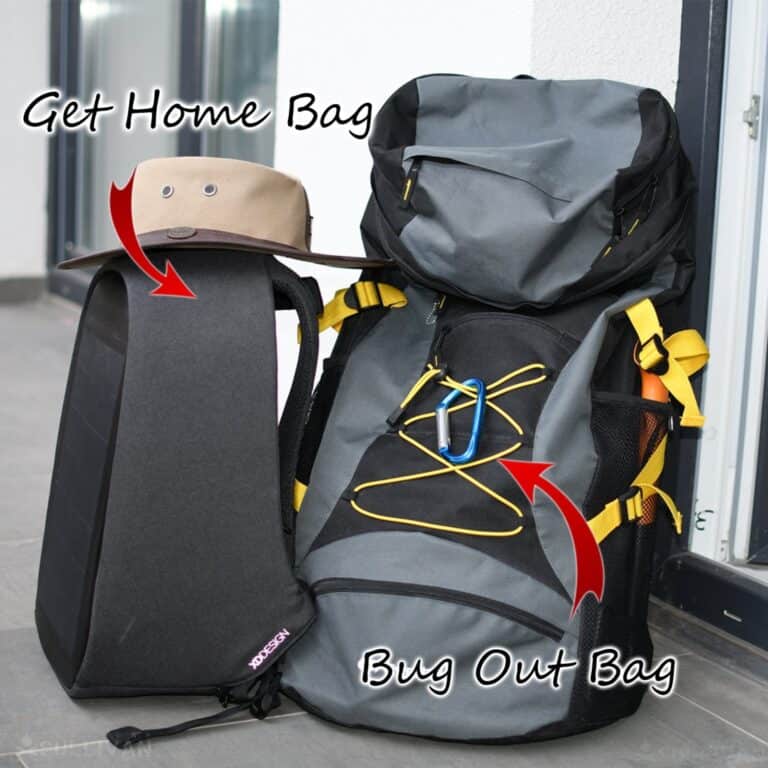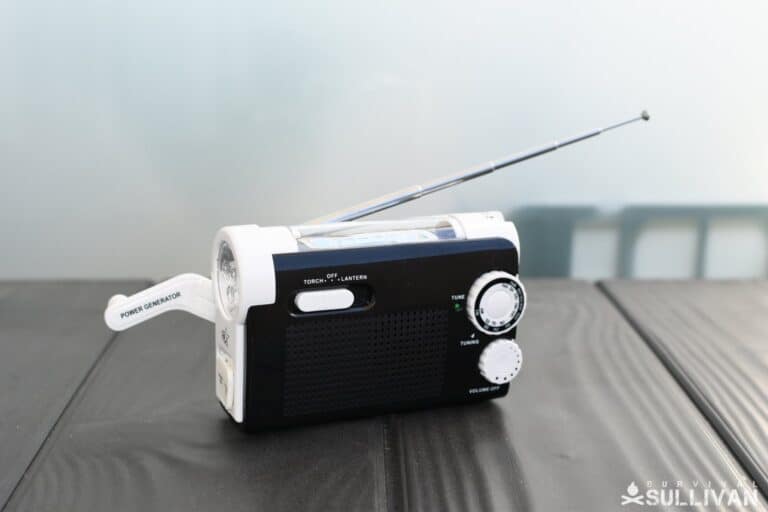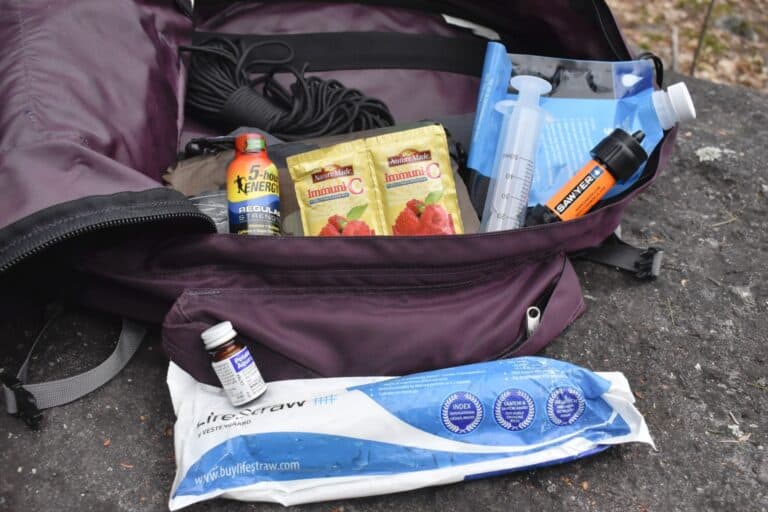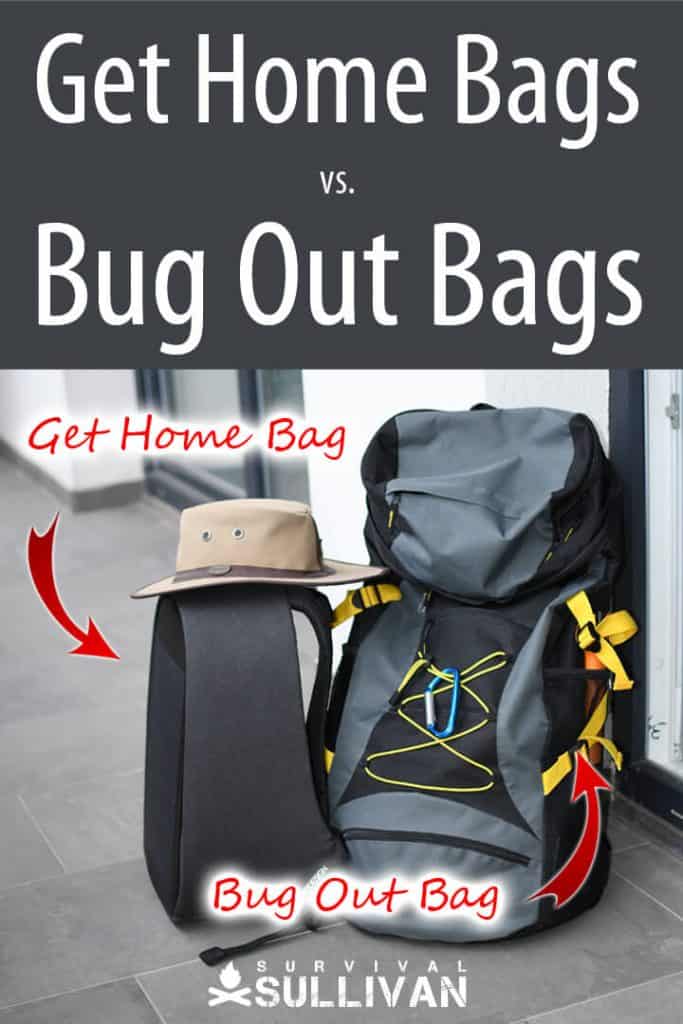Although most people know what a bug-out bag is, many get confused when it comes to get-home bags (GHBs for short). They are not the same thing! So what’s the difference between a bug-out bag and get home bag?

A bug-out bag is a solid backpack designed to help you survive away from home for up to a week, while a get-home bag is a lighter bag designed to get you home in an emergency, which hopefully won’t take you more than a few hours.
A bug-out bag (BOB for short) typically weighs around 20 to 40 pounds (more or less around 10 to 15 kilograms), although the less the better, because it will be heavy to carry on your back. A get-home bag typically weighs half as much as a get-home bag.
A bug-out bag is typically kept at home, in a place that’s easy to grab and go in case of an emergency, while a get-home bag is something you typically take with you, to keep either in your office, or inside your car.
Let me put things into perspective with this comparison table that highlights the differences between the two:
| Get Home Bag (GHB) | Bug Out Bag (BOB) |
|---|---|
| 10 – 20 lbs | 20 – 40 lbs |
| helps you survive for a few hours | helps you survive up to a week |
| 0.5 liter water bottle | 0.5-liter water bottle |
| very little food | more food, more diverse food |
| no need to acquire extra food | need some means to acquire more food and water |
| small first aid kit | medium-sized first aid kit |
| lightweight shelter options (tarp, poncho) | better shelter options (tent) |
| one folder knife | folder plus a solid survival knife or machete |
| no need for bartering items | should have a few bartering items |
To make things clearer, below we’ll detail the different items you should consider packing for each.
What’s in your Get Home Bag vs your Bug Out Bag?
The basic items you need to get home from wherever you may be when a disaster hits are in the GHB. It’s a plain backpack, messenger bag, or laptop bag, no bright colors or camouflage print.
It won’t draw attention and announce your bag full of supplies to everyone you see. You look like just a normal guy trying to get home from work, not GI Joe on a mission.
Unlike the GHB, your BOB should contain everything you need for at least 3 or 4 days. If you have room to include most of the items on this 154 bug-out bag essentials list that’s great too.
This is the large carry-everything-bag you grab and take with you when SHTF and you are forced to leave your home and travel to a pre-determined bug-out location (BOL)
Food
In your Get Home Bag:
For your GHB, think of quick, easy foods you can eat while on the move if need be. Items that don’t need heating and yet still provide the protein and calories you need are good.
Your GHB is a great place to have granola bars, energy bars, or even a candy bar if the weather is not hot. Throw in an MRE ration or some pemmican, a small bag of nuts, and a foil pouch of tuna with crackers.
Remember you can survive up to 3 weeks without food, so though uncomfortable, you can certainly go 24 hours without eating. Your priority is to get home, meet up with family, and either fortify your home to bug in or move on to your bug-out location (BOL). You won’t be stopping to cook meals.
In your Bug Out Bag:
Your BOB should be light enough to carry for long periods, but this is where you carry foods that require cooking as well as food you can eat quickly if need be. Ramen noodles, rice, peanut butter, and bouillon cubes are great to have. Don’t forget a stainless steel pot for boiling water, camp stove, a can opener, metal eating utensils.
Water
In your Get Home Bag:
Carry a small water bottle and a LifeStraw filter if you can. Purified water is okay but has more added chemicals. Save the bottles to refill if needed before you reach home.
Remember, your GHB is only designed to get you from wherever you are to home, so the worst case is an overnight trip if you have to travel on foot.
In your Bug Out Bag:
Your bug-out bag should also have a personal water filter, plus at least 1 liter of water, preferably kept in a stainless steel water bottle.
For your BOB, in case you need to refill, water purification tablets work on most things in about 15 minutes. For cold, dirty water, wait up to 4 hours before drinking. A 4 way sillcock key (to open water valves and faucets on buildings) is handy.
First Aid and Clothing
In your Get Home Bag:
A small first aid kit with Band-Aids, antibiotic cream, aspirin, and maybe some sunscreen will work here. A jacket, a rain poncho, and sunglasses to protect you from the weather.
Carry a change of clothes in case you do get wet and warm gloves and a hat in the winter season. A pair of tennis shoes or hiking boots and extra pair of socks in case you are wearing dress clothes when SHTF.
In your Bug Out Bag:
Your BOB first aid kit will be larger and include any items you can get for trauma, surgery, or stitches and any medications you or your family members need long-term.
It’s a good idea to include an EPI pen in case of an allergic reaction and an anti-diarrhea medicine. In your BOB, you will need duplicates of the clothing already in your GHB but include several sets of clothes and several pair of warm socks.
Important Documents
In your Get Home Bag:
It’s a good idea to include recent photos of each family member in the event someone is lost during the chaos and you need the photo for a search.
In today’s age of smartphones, a written list of emergency and family phone numbers in case your cell phone is dead will be crucial. A piece of paper and pen or pencil for writing a note or writing directions may be helpful.
In your Bug Out Bag:
Your bug-out bag (BOB) is the place to keep copies of all your important documents. This includes copies of birth certificates for each person as well as copies of insurance documents.
Cherished family photos, any other valuable items, and a written inventory of household items with serial numbers go here as well. A topographical map and compass will help you navigate unfamiliar territory.
Shelter
In your Get Home Bag:
A plastic tarp, a rain poncho, or a Mylar emergency blanket in your GHB is smart. Remember you are trying to get home, meet up with your spouse and children, not sleep in the woods. You need to travel light and will only need shelter if the weather is bad or it takes you a lot longer to get home than you expect.
In your Bug Out Bag:
It’s not always practical to carry a tent unless you can find a small pop-up that is light and folds small. Your BOB will carry all the tools you need to build a shelter if needed.
Include the basic tarp or plastic sheeting and paracord, as well as an axe or handsaw for cutting down limbs. Mylar emergency blankets are a good backup, at least one for each family member.
Protection
In your Get Home Bag:
A good survival knife. Even if you already carry an EDC knife on your person, one in your GHB follows the two is one and one is none philosophy.
For most people, your EDC pistol and ammo will be in your GHB or car unless you work somewhere that still allows you to carry it on your person. Pepper spray, OC spray, or wasp spray are alternatives for those who don’t carry a gun.
In your Bug Out Bag:
Your best survival knife, and a good folding knife should be at home in your BOB. It’s also a good idea to include protective gear such as N-95, N100, or R95 respirator masks for each family member. At least one good pair of safety googles and a pair of work gloves are helpful to prevent blisters and other injuries.
Communications and Bartering
In your Get Home Bag:
An old cell phone, fully charged for dialing 911 is always good to have. Include a portable phone charger with multiple options so you can plug in to either a car cigarette lighter, the wall (if power is on), or even hand-crank to charge if needed to communicate with family members.
Twenty dollars or more in small bills and change to use in vending machines is a good idea. Some waterproof matches, several lighters, and a small personal hygiene kit with a toothbrush, deodorant, and wet wipes are great additions too. Being able to wash your face after hours of traveling on foot can be refreshing and help keep you going.

In your Bug Out Bag:
Your BOB is the place for an emergency or weather radio that can be solar-powered. This will help you keep track of what’s happening around you during a long-term crisis. A pair of handheld radios or walkie-talkies with long-range will help you communicate with family members if your group is separated.
Items for bartering such as alcohol or coffee for bartering with as well as cash and your silver coins if you choose to stockpiles those, should be in your BOB.
You’d be surprised at what some people will trade for coffee in a crisis. Your BOB needs several ways to start a fire such as lighters, waterproof matches, flint, and magnesium rod as well as your fishing kit and snare wire.

Other Items
In your Get Home Bag:
If there is room in your GHB, a bandana has many, many uses. It can keep sweat from your eyes, filter water, or protect your nose and mouth from debris.
Keep a whistle around your neck or in your GHB so you can get the attention of loved one in a crowd. A flashlight and batteries, a screwdriver or multi-tool, some duct tape, and a can of fix-a-flat will come in handy for any minor repairs.
In your Bug Out Bag:
A battery-operated flashlight that can be powered multiple ways and a headlamp for each person. Add scissors, a sewing kit, extra batteries in varying sizes, a high-quality multi-tool, and several yards of duct tape. Include a folding shovel and a small gas can if you have room.
Lightweight books or a Kindle with info on edible plants and plant healing uses and some on tree identification are valuable in the woods.
Final Words
In the end, items in your GHB may overlap with your BOB but basically, your GHB is for short-term twenty-four hours or less. It’s the bag you always have within reach and it’s the one you will use until you get home safely or get to your BOB.
The bug-out bag is the end-all-be-all bag. This is the bag that you invest in, the items in this bag are ones your life will depend on in a long-term crisis.


Born and raised in NE Ohio, with early memories that include grandpa teaching her to bait a hook and watching her mom, aunts, and grandmothers garden, sew, and can food, Megan is a true farm girl at heart.
For Megan, the 2003 blackout, the events of 911, and the increasing frequency of natural disasters like Hurricane Katrina, spurred a desire to be more prepared. Soon to be living off-grid, this mother of four and grandmother of ten is learning everything she can about preparedness, survival, and homesteading.

I’m very happy to see your comment about your GHB and BOB overlapping…because mine do. Many EDC gear will find its way into the end-all-be-all packs because most families of 4 don’t have the $$$ to buy 4 Leatherman for 4 packs.
Under “protection” you listed wasp spray. Please stop perpetuating the myth that wasp spray is effective as a deterrent. It is not. It is nothing like pepper spray. There is no capsaisin in it. It is basically useless on anyone over than 8 years old. Do the research and stop the myth. This will get someone killed if they think wasp spray is effective against an attacker.
True, but wasp spray combined with a lighter or matches is a very effective defensive tool as most wasp sprays are petroleum based and make a terrific makeshift flamethrower in an emergency situation!
Just wondering if you spoke from personal or anecdotal experience.